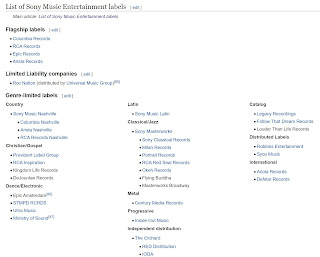I wanted to research the UK music industry before planning anything. I found out that Sony BMG is seen to be one of the 'Big Three' recording labels which dominate the UK scene, alongside Universal Music Group and Warner Music Group. My fictional artist has been assigned to Sony UK (CEOed by Jason Iley since 2014) in the set brief and so I wanted to find out how Sony worked and it's beliefs.
Sony is a massive conglomerate that is vertically and horizontally integrated (owned by Japanese company SME) and is home to some of the worlds biggest artists. Artists such as Mariah Carey, The Jackson 5, One Direction and Camilla Cabello. It has a total net worth of $7.27million and owns many smaller labels such as Columbia Records and Ministry of Sound.
As Sony is both vertically and horizontally integrated, it means that it owns it's own in house production and recording studio. This allows them to maximise their profits as they don't need to go pay another company to help them produce or record.
Sony also has many subsidiaries within the company which specialise in different genres of music which help ensure that the quality of music that is bought out will be at a high.
Artists that sign onto record companies are usually signed onto an exclusive contract. This contract will usually last either 3, 7 or 10 years where the artist would work exclusively under the company and get a certain percentage of their total earnings whilst the majority of it goes to the company.
Sony's contract shows that their artists earn about 10% of the royalties that they make. This is common in many contracts, however, Sony has come under fire for abusing this contract and has been dubbed to give out 'slave contracts'.
Artists such as Ke$ha have come out to say that Sony has wrongfully mistreated her, overworked her and underpaid her, disillusioning many to the supposed easy life of a superstar.
Despite this, Sony still remains as one of the largest records and is proliferate in the UK music scene. They are particularly successful in pop where they took up 29% of the top 100 and 34% of the top 40 in the 2017 UK charts.
By looking at Sony and understanding how it worked, not only in comparison to its competitors but also its relationship with its artists, I was better able to create a vision of my artist. I understand that Sony has a massive catalogue of artists and was able to provide a good budget for my artist, however, I needed to ensure that my artist would be unique and have longevity and a mass appeal, due to the genre of pop stated in the brief, but also as Sony would be keen on making profit through my artist brand image. Therefore, I decided that I would use stop motion as my USP for my music video and that for my actual artist, I would make their gender and sexuality unknown. This is due to the fact that a persons gender and identity and become a large topic of debate lately and many youths have difficulty in understanding themselves and their identity. Furthermore, although gender and sexuality shouldn't cause different perceptions to be held on people, they often do, especially in music where labels may exploit an artists sexuality and gender (for example the sexualisation of women in music). By making my artist's gender and sexuality unknown and play it down, it can help include a lot more people who aren't represent in the media whilst also reflecting Sony's agenda of being home to a wide range of unique and inclusive artists.





No comments:
Post a Comment